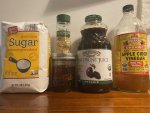These look more like toppings than casings. I have found on my own homegrown...
one cup of warm water
about a Tablespoon of honey
half a teaspoon of malic acid
half a teaspoon of citric acid
This is not so much for taste as preventing mold by increasing the acidity to a range above where mold will grow. The touch of honey is barely detected in the smoke, but the malic acid mixed with Virginias adds a touch of warm apple flavoring.
I will be trying mead on my next crop, in place of honey and water, as the alcohol will help it soak in without adding too much honey flavoring.
The purpose of the casing is to help prevent mold, slow the burn rate, and compliment the tobacco flavoring... although on a commercial level, they add proprietary flavors for branding. Stokkeby, MacBaron, Sutliff, etc... seem to be the most obvious at this.







